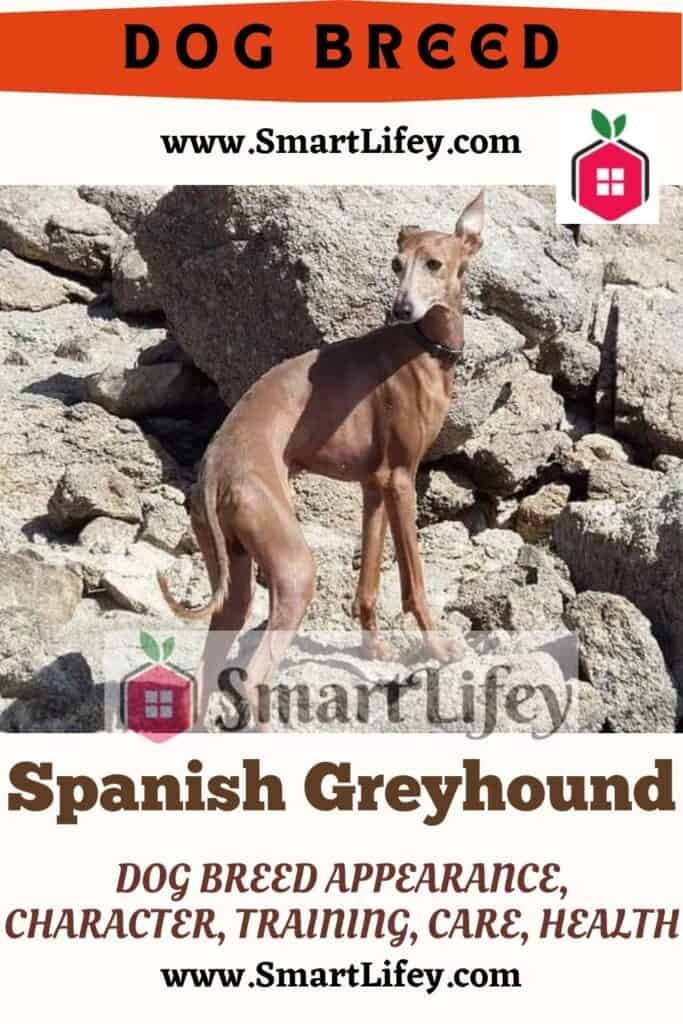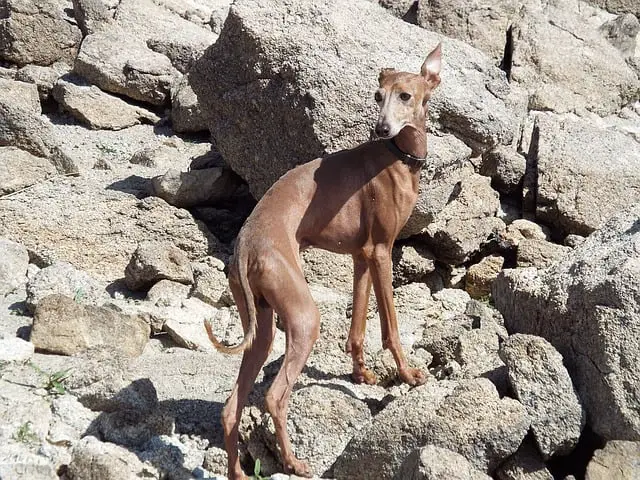
The Spanish Greyhound dog breed is characterized by its large size, elongated body and elegant lines. Although somewhat shy, it shows a noble and loving character with the whole family. In addition, its behaviour is very good with other dogs and pets. At Petlifey, we tell you about the character and characteristics of the Spanish greyhound.
Character of the Spanish Greyhound breed
The Spanish greyhound has a serious and withdrawn character at times. However, it should be noted that, despite being reserved, it is a very affectionate dog that tends to get along very well with other dogs, with other pets and with people.
In the hunt it shows a behaviour of great energy and vitality. In general, it uses its eyesight above all, and while it works it maintains a sober, tough and very persistent attitude.
Due to its proud and independent temperament, the Spanish greyhound has traditionally been used for hunting large game and for hunting hare in the open field, in which the dog chases the piece and catches it without human intervention.
In addition to its virtues as a working animal, both in hunting and in races, where it obtains very good results, it must be added that in recent years the Spanish greyhound has been demonstrating its undeniable qualities as a companion animal.
- Energy: High. Energetic and lively in hunting and running, it is an active animal that needs a lot of exercise on a daily basis.
- Temperament: Proud, independent and serious, it is somewhat withdrawn, but kind, loving and noble.
- Adaptability: Medium / High. It adapts to life in an urban environment as long as it is allowed to do a lot of physical activity.
- Sociability: Medium / High. It is affectionate with members of its family and with other dogs, but shy with strangers.
- Health: Good. The breed has hardly any serious or serious diseases associated with it.
- Longevity: Medium. Live between 10 and 12 years.
- Utility: Versatile. Basically it is a hunting dog widely used for racing and as a companion animal.
Is it a dog for the whole family?
With little care and a good dose of affection, the Spanish greyhound becomes a pleasant, calm, loyal and affectionate companion with whom you can enjoy fun outdoor exercise sessions with the whole family.
Can you live in an apartment or in the city?
It must be taken into account that it is an animal that needs to do a lot of daily exercise, so it is not the most recommended dog for families or people who live in a small apartment or who do not intend to carry out any physical activity with their greyhound.
How does it behave with other pets?
It is a noble animal that adapts well to life inside the home and that even willingly tolerate the presence of other dogs and other pets, such as cats or guinea pigs, if it gets used to it at a very old age. early.
However, it is somewhat shy and withdrawn around strangers, but it is never aggressive or violent.
Characteristics of the Spanish Greyhound
The main characteristics of the Spanish Greyhound are its large size, elongated body, elegant lines and beautifully stylized silhouette. All of this results in a dog with an overall elegant appearance.
The Spanish greyhound is large, muscular and compact, but it is agile and flexible. It has a very narrow head, a well developed thorax and a well retracted belly. Let’s see it in more detail:
How is the Spanish Greyhound physically?
Body
It is a large dog with a long body, elegant lines and a beautifully stylized silhouette. The cross stands out in the line of the back. The chest region is highly developed and the belly, very retracted, delineating the classic chunky profile characteristic of these dogs.
It has the so-called ” hare’s feet “. The fingers, tight and high, have strong and long phalanges, with strong and dark nails. The pads are hard and large.
The tail is inserted in the low position and is thick at the root and finer in the pun-ta. It hangs between the hind limbs and is flexible and very long, reaching below the hock and sometimes touching the ground between the hind limbs, something characteristic of the breed.
At rest, the dog wears a sickle-shaped tail, with a very pronounced final hook inclined to one side.
Head
The head is long, narrow and dry, with very marked profiles. The muzzle, long and narrow, ends in a small, blunt nose, always black.
Their eyes are small and almond-shaped, their irises are dark in color. Their gaze is calm, sweet and reserved. The eyelids are very thin and well attached to the eyeball.
The ears are triangular in shape, set high and wide and fleshy at the start, and thinner and finer at the tip, which is rounded in shape.
When the dog is attentive, it straightens them in its first third and keeps the tips bent to the side. When at rest, they hang in the shape of a rose, attached to the skull.
Fur
In the short-haired variety it is dense, very fine and smooth, and it is distributed throughout the body, even in the spaces. It is slightly longer at the back of the thighs.
In wire-haired dogs it is rougher and longer. It may have a beard or moustache on the face, bushy eyebrows and even a toupee on the head.
Colour
There is no characteristic color of the breed. The following are considered the most common: barcino and brindle more or less dark; black, dark or light waffle, tan, tan, yellow, red, white, pronghorn (i.e. white background with dark spots) and piebald (brown and yellow).
Spanish Greyhound breed standard
- Origin: Spain.
- Size: Very large.
- Height at the withers: between 62 and 72 cm for males and between 60 and 70 cm for females.
- Weight: There is no established standard weight for this breed.
- Varieties: Short-haired and wire-haired.
- FCI Classification: FCI nº 285. Group 10 – Sighthounds. Section 3 – Shorthaired Sighthounds.
- Other names: Spanish Greyhound / Lévrier espagnol / Spanischer Windhund.
- Use: Hunting, racing and company.
- General appearance: It is a very elegant sighthound, with a compact skeleton, a long and narrow head, a wide thorax, a very retracted belly and a very long tail.
- Head: In proportion to the rest of the body, it is long, lean and thin.
- Skull: Narrow and with a subconvex profile, it is crossed by a well marked central groove in its first two thirds and not so much in the frontal sinuses and the occipital crest.
- Nose-frontal depression (stop): It is soft, very little accentuated.
- Muzzle: Long, with a narrow bridge of the nose, it has very thin and thin lips, and the upper one covers the lower one.
- Nose: It is small, moist and black.
- Jaws: They are armed with strong, white and healthy teeth, with well developed ranins. The bite is regular and complete in scissors.
- Eyes: They are small, oblique, almond-shaped and of dark colors, like hazelnut. Its gaze is calm, sweet and reserved.
- Ears: Triangular in shape, fleshy and wider at the base, they present the first third bent upwards and to the sides. When the dog is attentive they remain slightly upright
- Neck: long and oval in section, flat, slender, strong and flexible.
- Body: Rectangular, strong and flexible, it gives a feeling of strength, agility and resistance.
- Back: It is straight, long and well defined. The loin is long, strong, not very wide and with an arched upper edge and provided with a compact, elastic and strong musculature. Its rump is on a desk, long and powerful.
- Chest: It is deep, although it does not reach the elbow area, and very long. The tip of the sternum is well marked. It has flat, visible and marked ribs and a good thoracic girth.
- Tail: Very thin and long, it is characteristic of this breed that, when the dog is at rest, it carries the tail between the hind limbs, with a hook-shaped curve in the final section.
- Forelimbs: They are perfectly plumb, and are thin, straight and parallel.
- Shoulders: They are dry, short and sloping. The shoulder blade is noticeably shorter than the arm.
- Forearms and arms: The first are very long, straight and parallel; they have well-defined bones and well-marked tendons. The arms, longer than the shoulder blades, are very muscular.
- Hind limbs: They are powerful, well poised and have a well defined skeleton. The musculature is long and well developed.
- Legs: They are very long and have marked and fine bones. The upper part is much more muscular than the lower part, and veins and tendons are easily visible. The thighs are strong, long, muscular and taut.
- Knees: They present a correct angulation.
- Hocks: They are well marked, with a clear appreciation of the tendon, which is highly developed.
- Feet: These are known as “hare’s” feet, with tight, high toes, hard, well-developed pads, and large, black nails.
- Movement: The movement in which the dog reaches maximum efficiency is the gallop. The trot is long, elastic and powerful, and it develops at ground level, without raising the legs much.
- Skin: Very close to the body in all its areas, strong and flexible, it is pink in color with dark mucous membranes.
- Hair: It is thick, short and smooth, somewhat longer at the back of the thighs.
- Color: It can present very different colors. Among the dominant colors in the coat of greyhounds, the brindle is one of the most seen
Education and training of the Spanish Greyhound
Because of its character somewhat reserved, it is highly recommended socialize it from chub-I vel exposing them to all kinds of different situations, so that a balanced and stable temperament is forged, and not become an exemplary shy in adulthood.
Also, although it is not one of the most prominent breeds in dog training , if positive methods are used in its education , it is quite easy to get it to acquire good manners.
The important thing is that its owner is capable of exercising firm and solid leadership at all times , that it provides the dose of exercise it needs and that it meets all its hygienic, sanitary and emotional needs.
Health, diseases and nutrition

The Spanish greyhound is characterized by being a fairly healthy breed, but even so it is advisable to prevent and control the typical diseases of sight hounds and large dogs.
For example, you can suffer from hip dysplasia , bone cancer and, above all, stomach torsion. In this sense, it is advisable to serve them food in elevated containers to avoid having to lower their long neck to ground level.
If it is well cared for, the life expectancy of the Spanish Greyhound can exceed 10 years. But the truth is that this varies a lot between individuals depending on whether they are hunters (with the consequent physical wear and tear that this entails), or if they are animals that live as simple pets and that, therefore, enjoy a higher quality of life.
